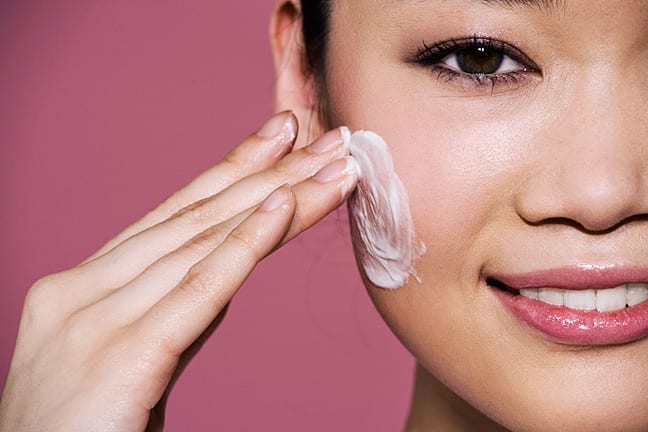If you still have young, tight, healthy skin, you can take steps to ensure it stays that way. The challenge is sifting through all the different products that purport to be youth serum.We’ll help you separate the skin savers from the money wasters so you can feed your skin with nutrients, and protect it from UV damage and toxins throughout the day.
QUIZ: Do You Have Healthy Skin?
Check Labels
When you cruise the drugstore aisles, you’ll find thousands of products. The trick is discerning which will weigh down your skin and lighten your wallet versus those that will really do something.
Look for products that list an “active ingredient” and a particular concentration. To make a difference, vitamins in lotions and creams should be in the one to 10 percent range. The formulations should also be pH balanced. Products that make therapeutic claims must be scientifically proven to be safe and effective, and FDA-regulated.
The Big Guns
There’s very little science to the many skincare ingredients out there. The list of those that really make a difference in the skin is small. Here are the most potent ingredients (and their close relatives) to know:
- Vitamin A (retinoids)
- Vitamin B (niacin or nicotinamide)
- Vitamin B5 (pantothenic acid, panthenol)
- Vitamin C & vitamin E
- Alpha-hydroxy acids
- Ubiquinone or coenzyme Q10 (small-molecule antioxidant)
- Ferulic acid (small-molecule antioxidant)
These eight skincare ingredients you can slather on with the comfort of knowing they have scientific backing. It makes sense to steer away from hexapeptides and collagen, as they are too large to penetrate the skin. However, smaller peptides are OK.
Know Your Vitamins
You know you need to ingest them, but vitamins are also important topically. These are three of our favorite for good skin health.
MORE: Butternut Squash, Carrot and Ginger Soup Recipe for Healthy Skin
Vitamin A: One of the most valuable nutrients to be applied to the skin is vitamin A (not in a vitamin pill). Without vitamin A (a retinoid), your skin, hair and nails would be dry and you’d be sickly. Vitamin A is found as retinoic acid (Retin-A), retinol (retinaldehyde) or retinyl-propionate. (If you could be pregnant, consult your doctor before using vitamin A products.)
All of these forms of vitamin A work—your body can transform one into the other. Retinoic acid knocks out bacteria and helps regulate shedding of the dead skin layer and pore-clogging oils (this decreases visible pore size). Topical vitamin A increases elastin fibers, the structural collagen and your natural moisturizer, hyaluronic acid. It lessens dark pigmentation and is the first-line drug for acne, rosacea and seborrheic dermatitis.
Retinoids are really the only thing you can put on your skin that can repair sun damage, and give you smoother, less wrinkled skin. Most importantly, retinoids decrease actinic keratosis—spots that can become skin cancer. It can even help stretch marks. Light renders vitamin A unstable and ineffective, so don’t put it on skin in the morning! Use it at night instead.
Vitamin C: This is one of your skin’s main water-based antioxidants. You can raise the vitamin C levels in your skin by 40 times, by rubbing in at least a 10-percent concentration of L-ascorbic acid. Vitamin C rapidly breaks down with UV light. So again, use it at night, when it can stimulate collagen and help you build younger-looking skin. It will last a long time, or until deactivated by UV light.
Vitamin C protects against sunburn and sun-induced wrinkling. It knocks out free radicals and inflammation after UV exposure. It can also reduce the rosy rosacea look and brown age spots. It has a greater affect when used in conjunction with vitamin A.
Vitamin E: The major lipid-soluble antioxidant hitches a ride to the stratum corneum (the dead upper skin layer), with your natural oils (called sebum). Topical vitamin E needs to be used in the form of Dl-alpha-tocopherol to make a positive effect on your skin. Many skin creams contain tocopherol acetate—this doesn’t do the magic of alpha-tocopherol. The acetate may actually hurt your skin.
Also of note, vitamin C needs vitamin E. Vitamin C is water soluble, an effective scavenger of free radicals in the water-soluble parts of your skin. And vitamin E works on the lipid-soluble parts. If all you use is vitamin C, the lipid part of the cell ages. The effective form of vitamin E (DL-alpha-tocopherol) enhances the effects of sunscreen, stops the immune system from getting blitzed and slows wrinkle formation. Vitamin E should be applied along with sunblock or at night, as UV light degrades it (like vitamin C).
Other Antioxidants
Different plants make sunscreens to protect from the UV light. Each of these dark-colored antioxidants can give the skin benefits. Many antioxidants have red, blue or green pigments, which can be unappealing in skin creams and few studies have shown these to work in humans. Newer antioxidants include ferulic acid, idebenone, ubiquinone (coenzyme Q10), alpha lipoic acid and resveratrol and are already featured in many skincare products.
MORE: Skin-Boosting Antioxidant Salad
Oil UpOlive oil should find its way into makeup and skin creams. It has been shown to decrease UVB skin damage. Extra-virgin olive oil even works better, we think. (Note: This can be a skin irritant in some people.)To make an olive oil bath, add ¼ cup olive oil with a few drops of lavender or peppermint oil to bathwater. Olive oil’s the most natural of moisturizers and can be used on the scalp, hair, nails and lips.
Check For Co-Q10
Coenzyme Q10 helps prevent damage to lipids on the skin surface. Beware that many products listing Co-Q10 have less of it than advertised (like 90 percent less, or none at all)!
Check consumerlab.com, or look for the USP-verified symbol to make sure you’re getting what you’re paying for. The FDA started monitoring these labels in 2011.




































